This is a guest post by Janice, a California-based hiking enthusiast.
Winter is one of my favorite times to visit Yosemite Valley, and there are a variety of hikes that allow you to experience this magical winter wonderland.
I’ve always loved off-peak travel to Yosemite, especially during winter because of how quiet and peaceful it is. Even though many of the summer trails have closed, I look forward to experiencing off-the-beaten-path adventures that are available only in winter. For example, you can go snowshoeing under snow-capped trees and walk along icy lakes.
Whether you’re an experienced hiker looking for a challenge or a casual hiker, Yosemite offers lots of ways to experience the beautiful landscape. If the cold never bothered you anyway, you’re going to love these amazing Yosemite winter hikes:
1. Lower Yosemite Fall Trail
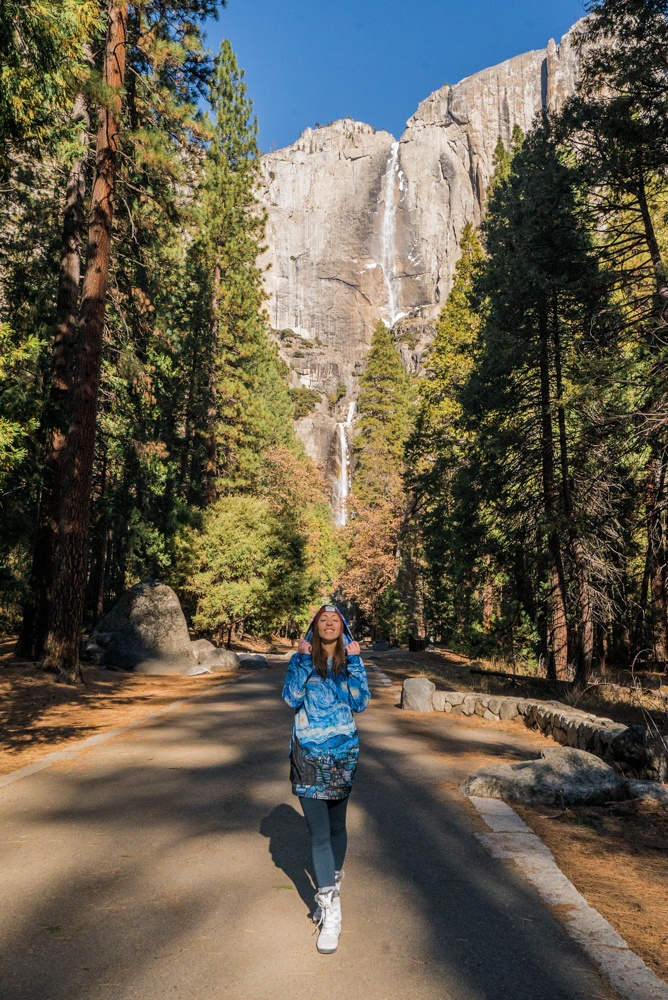
One of the easiest hikes in Yosemite Valley is the Lower Yosemite Fall Trail. It also offers a great view of the tallest waterfall in North America, which is nearly twice as tall as the Empire State Building!
On this leisurely walk, you’ll see both Upper and Lower Falls cascading down the ice-covered granite walls. This trail is short and easy, making it appropriate for most ages and fitness levels. I always take my friends here when they visit Yosemite for the first time.
This trail can also be extended into a full 1-mile loop, where the eastern part of the loop is wheelchair and stroller-accessible. While this trail is usually overcrowded in summer, you’ll get to enjoy quieter moments here in winter.

Getting there: There is a sizable parking lot across from the trailhead at Sentinel Bridge parking area. Alternatively, you can take the shuttle to Yosemite Village and begin your hike there.
Distance: 1 mile (loop)
Duration: 30 minutes
Elevation gain: Flat
Difficulty: Easy
Nearest shuttle stop: Lower Yosemite Fall (shuttle stop #6)
2. Valley Loop Trail
The Valley Loop Trail is easy and takes you to many of Yosemite’s most famous attractions including Yosemite Falls and Bridalveil Fall. It’s most beautiful when the valley is covered in snow as you’ll be passing through the meadows.
You could also choose to do shorter sections of the loop, and just take the free shuttle at the nearest stop to get back to your accommodation or your car. Hopefully you’ll find amazing winter deals for stays near Yosemite.
Getting there: You can join the Valley Loop Trail from the Lower Yosemite Fall shuttle stop, or from anywhere in the valley.
Distance:
- 7.2 miles (half loop)
- 11.5 miles (full loop)
Duration:
- 3.5 hours (half loop)
- 5-7 hours (full loop)
Elevation gain: Flat
Difficulty: Moderate
Nearest shuttle: Multiple shuttle stops throughout the valley, with Lower Yosemite Fall (shuttle stop #6) being a good starting point
3. Mirror Lake Trail
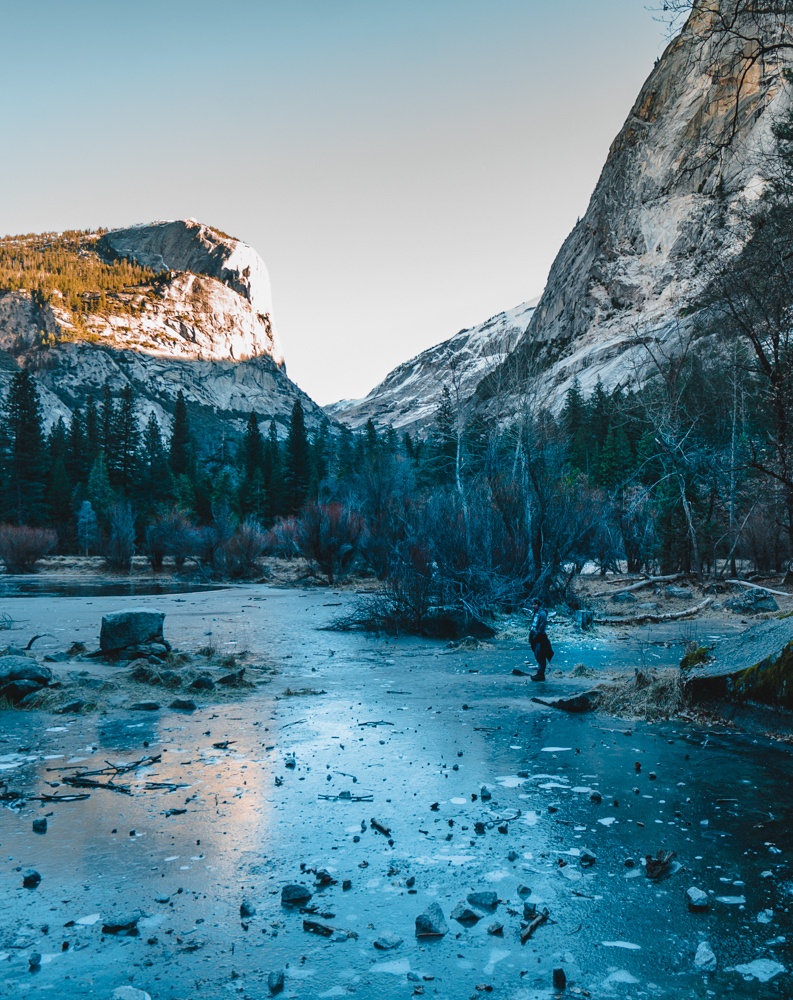
Another beginner-friendly hike would be an out-and-back trail to Mirror Lake. You can either hike on the pavement or through a moss-covered forest trail along Tenaya Creek.
While Mirror Lake is more of a meadow in summer, it fills up in late winter when snow melt flows into the valley. When the water is calm, it also acts as a mirror reflecting Half Dome along with the surrounding landscape.
For a longer adventure, continue along the Mirror Lake Loop as you hike beside Tenaya Creek for a total of 5 miles (2-3 hours). This extension allows you to enjoy more of Tenaya Canyon with views of Mount Watkins and Washington Column.
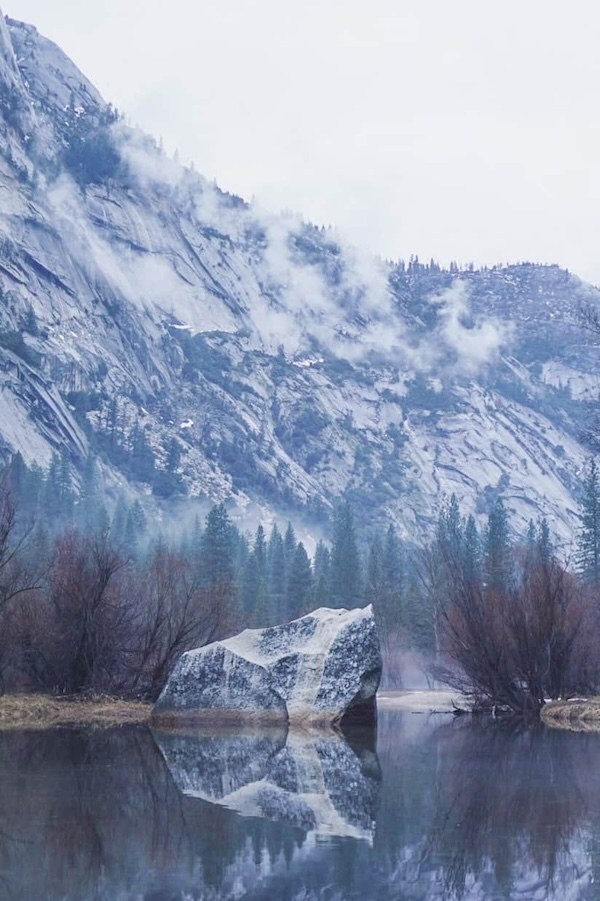
Getting There: Take the shuttle bus to Mirror Lake Trailhead via shuttle stop #17. You can also park at Curry Village and walk over to the trailhead. There are lots of signs so it should be easy to navigate when you’re there.
Distance:
- 2 miles (lake and back)
- 5 miles (loop)
Duration:
- 1 hour (to lake)
- 2-3 hours (loop)
Elevation gain:
- 100 ft (to lake)
- 200 ft (loop)
Difficulty: Easy to moderate
Nearest shuttle: Mirror Lake Trailhead (shuttle stop #17)
4. Mist Trail
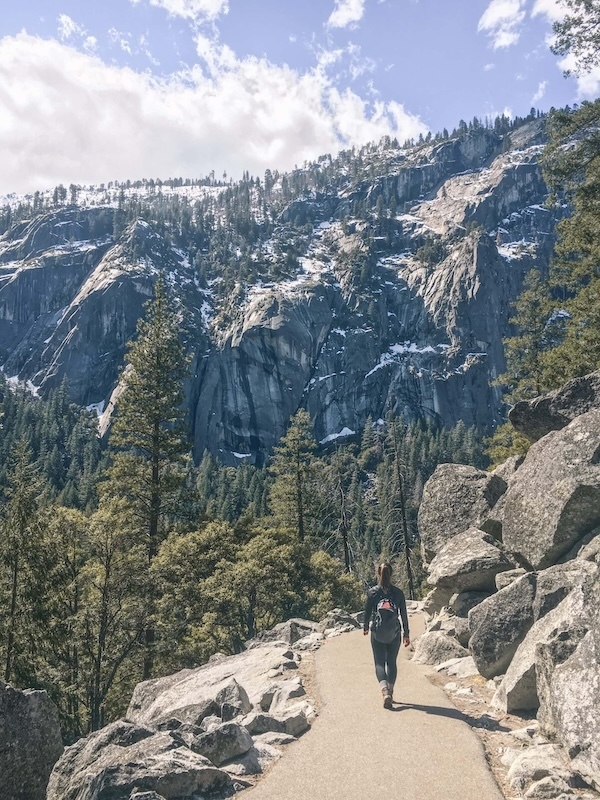
One of the must-do hikes year-round is the Mist Trail, and it’s even more stunning in winter. The winter version of this scenic trail takes you to the Vernal Fall Footbridge and Nevada Fall, though some parts of the trail might be closed in winter.
The easiest way to experience the Mist Trail is the short hike to Vernal Fall Footbridge. It’s a consistent uphill climb, so you might get breathless and sweaty even in winter. I love seeing the gushing waterfall from the footbridge against the backdrop of snow-covered granite peaks.
When parts of the Mist Trail are closed, you can consider taking an alternative route via the John Muir Trail up towards Nevada Falls for the full experience.
Getting there: Take the shuttle to Happy Isles and walk towards the Mist Trailhead.
Distance:
- 2 miles (Vernal Fall footbridge round trip)
- 2.7 miles round trip (Vernal Fall round trip)
- 5.7 miles round trip (Nevada Fall round trip)
Duration:
- 1-1.5 hours (Vernal Fall footbridge round trip)
- 2-3 hours (Vernal Fall round trip)
- 4-6 hours (Nevada Fall round trip)
Elevation gain:
- 400 ft (Vernal Fall footbridge round trip)
- 1,000 ft (Vernal Fall round trip)
- 2,000 ft (Nevada Fall round trip)
Difficulty: Moderate to strenuous
Nearest shuttle: Happy Isles (shuttle stop #16)
5. Glacier Point Road
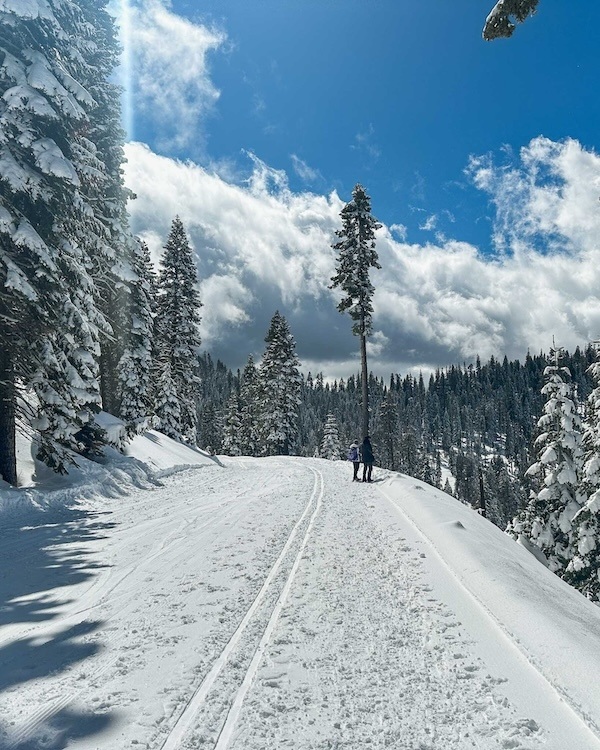
Did you know that you can still get to Glacier Point even in winter? It sits above the valley and offers panoramic views of the surrounding snow-covered peaks. As Glacier Point Road is transformed into groomed ski trails, you’ll have the opportunity to snowshoe or cross-country ski all the way to Glacier Point.
If you decide to make the 10-mile one-way trip to Glacier Point, you can spend the night at the Glacier Point Ski Hut which has a stunning view of Half Dome. This is a special experience that’s only available in winter, so I’d love to try it once I get a hang of cross-country skiing.
If you’re interested in a backcountry winter adventure, you could also get permits to camp off Glacier Point Road. Compared to visiting in summer, there are much fewer crowds and you get to enjoy an alternate view of the high Sierra.
Getting there: Drive to Badger Pass Ski Area (chains might be required). Alternatively, take the shuttle that leaves twice in the morning from Yosemite Valley to Badger Pass.
Distance: 20 miles round-trip
Duration: 1-2 days
Elevation gain: 2,600 ft
Difficulty: Strenuous
Nearest shuttle: Badger Pass Ski Area
6. Dewey Point
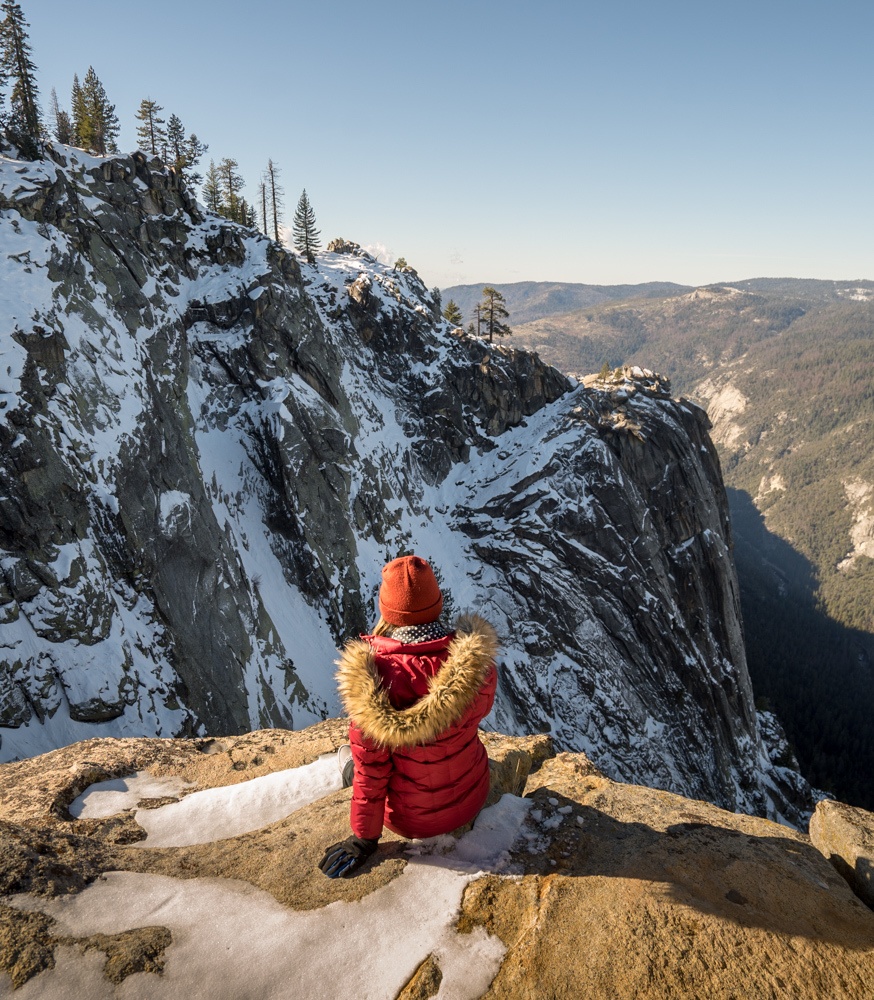
If you’re a beginner snowshoe or cross-country skiing enthusiast, consider starting out with a day hike to Dewey Point.
You can rent equipment at Badger Pass Ski Area, so you can try this even without any gear. For those that need a bit more guidance, there are also guided tours that take you from Badger Pass all the way to Dewey Point.
The trail takes you along the groomed Glacier Point Road, then to Ridge Trail (#14) or Meadow Trail (#18). As you get closer to Dewey Point, the trees start to clear and you’ll see more of the surrounding peaks.
It’s really amazing to see Yosemite Valley from this height, with Half Dome staring right back at you. As a beginner snowshoe hiker, I found Meadow Trail (#18) quite enjoyable with its moderate slopes and the same amazing view at the end.
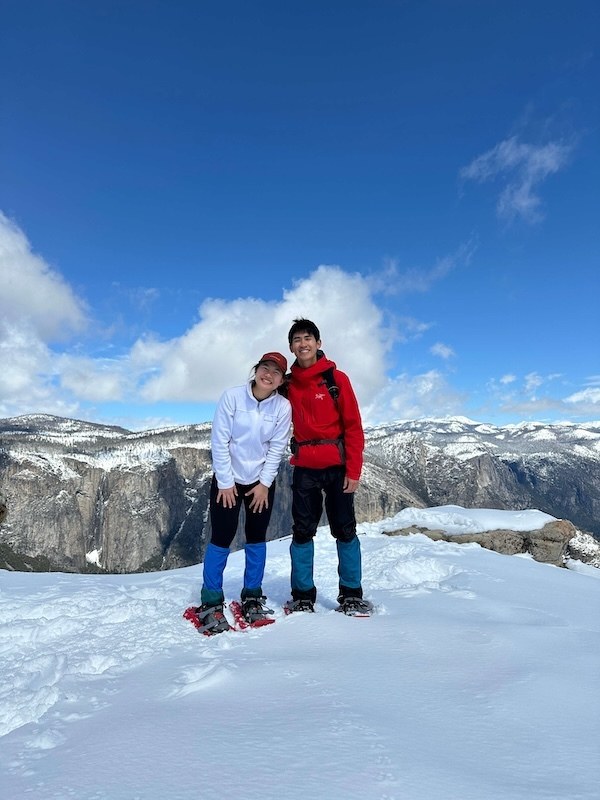
Getting there: Since the starting point is at Badger Pass Ski Area, the directions are similar to getting to Glacier Point. You can either drive up (with snow chains prepared), or take the shuttle from the valley. For this day hike, aim to take the earliest shuttle that arrives at Badger Pass at 9:30am, and prepare to return to the valley via the 4:30pm shuttle.
Distance: 7.2 miles round-trip
Duration: 4-5 hours
Elevation gain: 780 ft
Difficulty: Moderate
Nearest shuttle: Badger Pass Ski Area
7. Artist Point from Tunnel View
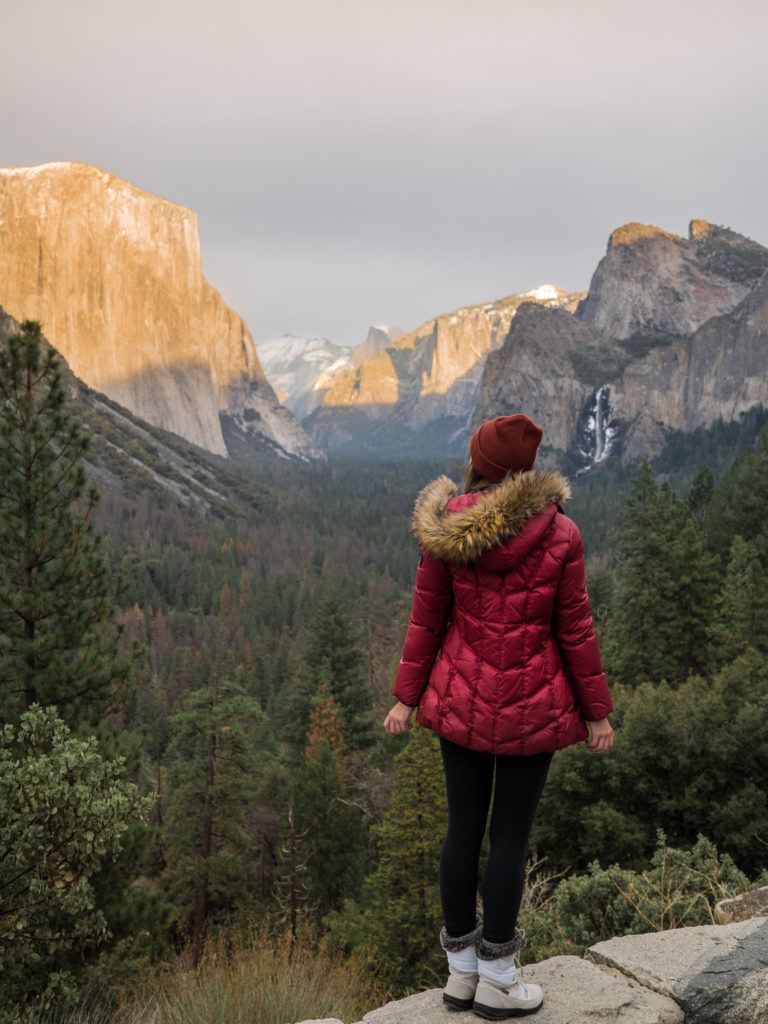
Most people know about the unmissable Tunnel View viewpoint, but did you know you can hike up to a less crowded vista? This is the Artist Point Trail that looks out to a similar view as Tunnel View, plus without the crowds.
After parking at the Tunnel View parking lot, follow the Pohono Trail and turn left onto the Old Stagecoach Road. It’s a short trail so you will see the clearing with a wide open view of the valley after just 0.5 mile.
Getting there: Park at the Tunnel View parking lot after entering from the South Entrance. If you’re coming from the valley, head out towards the South Entrance and make a small u-turn just before the tunnel.
Distance: 2 miles (round trip)
Duration: 1-1.5 hours
Elevation gain: 500 ft
Difficulty: Moderate
Nearest shuttle: None (Park at Tunnel View)
8. Bridalveil Fall Trail
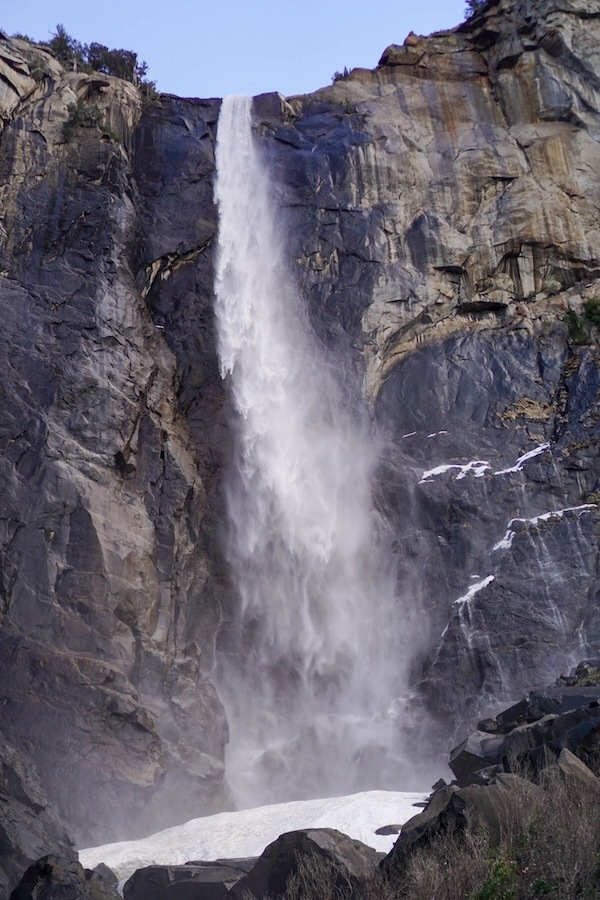
If you’re looking for a short and easy hike, you can consider checking out Bridalveil Fall Trail. You’ll find it flowing with water year round, producing a mist that can be felt while you’re looking up at the waterfall. In winter, you’ll also see a pile of snow and ice at the base.
The trail is mostly a paved walkway that is wheelchair and stroller accessible, making it an easy stop on the way into Yosemite Valley. While the trail can be busy, it’s well worth the short walk to see this iconic waterfall.
It could be icy and slick in winter, so watch your step and hold onto the handrails when checking out this trail. We got soaked when we came here on a rainy winter day, so make sure to bring a poncho or raincoat too.
Getting there: Although there are no shuttles leading to Bridalveil Fall, you can access it via the Valley Loop Trail. Alternatively, drive to the parking lot at the trailhead.
Distance: 0.5 mile (round trip)
Duration: 15 to 30 minutes
Elevation gain: 80 ft
Difficulty: Easy
Nearest shuttle: None (Parking lot at trailhead)
9. The Snow Creek Trail
Another epic winter challenge to take on is the Snow Creek Trail. This trail extends from Yosemite Valley near Mirror Lake, all the way up to the rim. You’ll most likely require snowshoes or microspikes on this trail due to the higher elevation snow and ice, and be prepared to gain significant elevation.
You can expect much fewer hikers here during winter, as it is a strenuous hike with lots of switchbacks winding around a narrow incline. The payoff for your effort is especially rewarding, as you get to admire the Tenaya Creek Canyon along with Half Dome. If you don’t wish to go all the way up, you can turn back anytime whenever you’re satisfied with the view.
Getting there: Access the Snow Creek Trail via Mirror Lake Trail, continuing past the lake towards the footbridge and then all the way up. You won’t be able to access Snow Creek Trail from the top since Tioga Pass is closed in winter.
Distance: 9.4 miles (round trip)
Duration: 6-7 hours
Elevation gain: 2,700 ft
Difficulty: Strenuous
Nearest shuttle: Mirror Lake Trailhead (shuttle stop #17)
10. Upper Yosemite Falls Trail
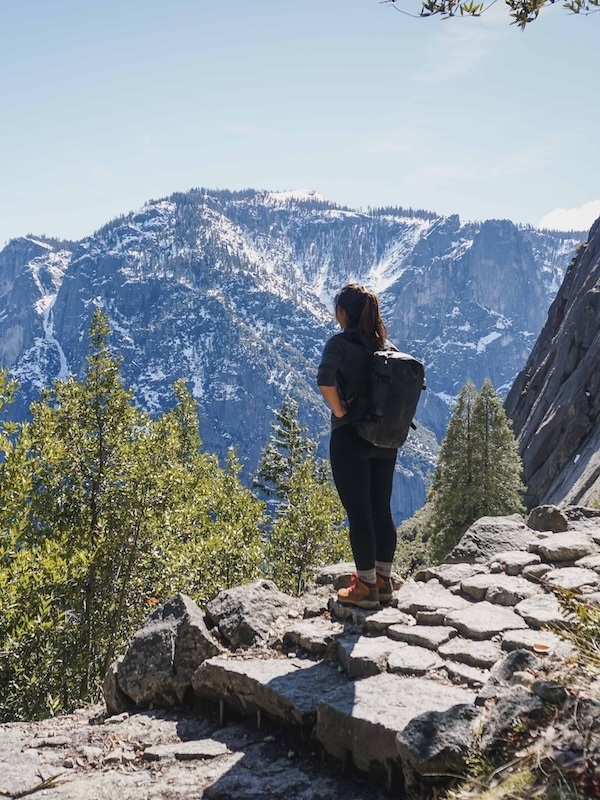
Another challenging and fairly popular winter hike is the Upper Yosemite Falls Trail. It takes you up to the top of North America’s tallest waterfall, and gives you an amazing view of Yosemite Valley along the way. It’s a relatively short but steep trail that follows a series switchbacks all the way until you reach the top.
Although this trail stays mostly open throughout the winter, it tends to get icy and snowy at certain parts, so I recommend bringing microspikes. I did this in just my hiking boots before, which made the slopes a little harder to grip onto.
If you prefer something easier, you can also hike till you reach Columbia Rock which is also a nice midway point for admiring the valley. Whichever end point you choose, this hike is worth it.
Getting there: The trailhead is located at Camp 4. You can either park at Yosemite lodge or take the shuttle to Camp 4.
Distance:
- 2 miles (Columbia Rock round trip)
- 7.2 miles (Upper Falls round trip)
Duration:
- 2-3 hours (Columbia Rock round trip)
- 6-8 hours (Upper Falls round trip)
Elevation gain:
- 1,000 ft (Columbia Rock round trip)
- 2,700 ft (Upper Falls round trip)
Difficulty: Strenuous
Nearest shuttle: Camp 4 (shuttle stop #7)
Conclusion
There are so many amazing winter hiking opportunities in Yosemite that it will take a few visits to experience them all! You could also enjoy ice skating, skiing, and huddling in a cozy cabin when you visit this National Park in winter.
With these trail suggestions, ranging from easy walks to challenging climbs, you’re sure to find the perfect adventure in Yosemite.
Remember to dress warmly, bring the right gear, and check trail conditions before you go. Prepare lots of snacks and water because you’ll definitely need all the energy you can get!
About the author: Janice is a California-based travel writer from Singapore, who discovered her love for hiking and camping during her studies in Los Angeles. Through Where’s Janice, she now shares detailed itineraries for adventures in California, Asia, and beyond. She also provides gear guides and tips for beginners so that they can explore the great outdoors with confidence.
Lydia says
Hi Kristin, I just can feel the adrenaline rush and the satisfaction after every hike and climb. What other places like Yosemite that you can suggest?
Kristin says
There’s nowhere like Yosemite! But anywhere in the Sierras is going to be awesome. Mammoth Lakes, Sequoia, King’s Canyon…
Alfredo Castro says
Hi, I’m trying to decide whether to go in November or not. In November there is already snow? it would be my first time and I heard that several trails are closed in that month
Kristin says
It depends on the year. Sometimes there is snow and sometimes there isn’t. It’s pretty magical when it does snow, so I think it’s worth it either way.
Lori Chaconas says
Hi Kristin,
I am traveling with my mother to San Fran the end of February. She has always wanted to see the giant Sequoia trees. Is it possible to visit Mariposa Grove from SF in a day and if not, is there a recommended place to stay nearby? Will i need to purchase snow chains to go?
Or is there a better alternative to going to Yosemite to see the trees March 1st?
Thank you!
Kristin says
Hi Lori, if I were you I’d at least overnight. Yosemite is amazing in the winter and so beautiful and there’s much more to see than the trees, which are amazing, of course. It’d be a pity to go all the way there and not stay for a bit. Chains will completely depend on the current road conditions, so take a look at CalTrans info before you go. They’re pretty good about ploughing what they can.
You can also consider Sequoia and King’s Canyon national parks to see the trees. Coastal Redwoods are similar in size and you can see those much closer to the city if desired, and without worrying about snow.